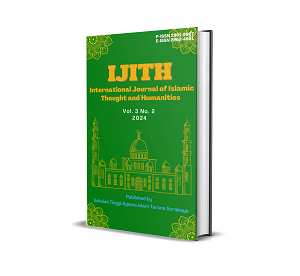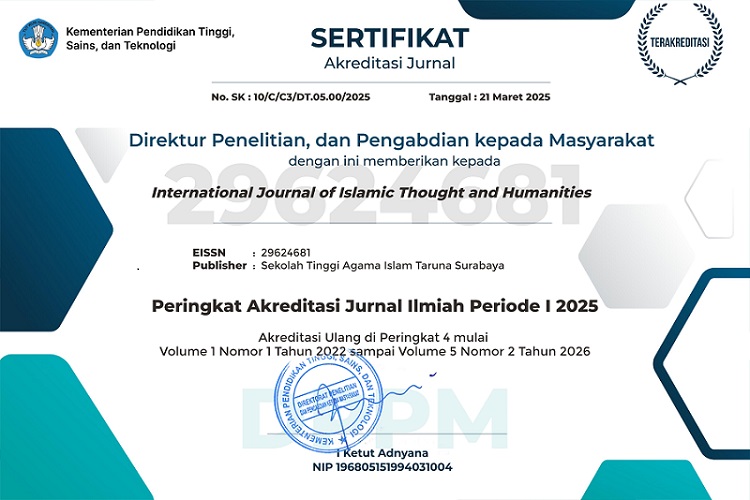Language Environment and Acquisition Dynamics of Arabic in Pesantren: Perspectives on Islamic Education and Learning Tradition
DOI:
https://doi.org/10.54298/ijith.v3i2.608Keywords:
Arabic Language, Language Acquisition, Language Environment, PesantrenAbstract
Language environment constitutes a fundamental pillar in second language acquisition, including learning Arabic within Islamic boarding schools (pesantren). The variation of input, the intensity of interaction, and the consistency of practice collectively form the primary scaffolds for developing students’ communicative competence. In the pesantren context, these elements are both pedagogical tools and part of a broader cultural and spiritual ecosystem that shapes language use in structured and spontaneous ways. When effectively designed and managed, this dual ecosystem has the potential to accelerate the process of Arabic acquisition significantly. This article examines the dynamics of the Arabic language environment in pesantren and its relationship with the core dimensions of input, interaction, and output. A qualitative case study design was employed, with participants selected purposively to capture diverse language learning experiences. Data collection involved observation, in-depth interviews, and document analysis, which were systematically analysed using Krippendorff’s content analysis framework, covering data reduction, thematic classification, interpretation, and conclusion drawing. The findings point to two interrelated categories of the Arabic language environment. The first is the formal environment, encompassing structured classroom learning such as maharat al-qirā’ah, al-kitābah, al-istimā‘, and al-kalām. This environment facilitates the acquisition of linguistic accuracy by aligning input and teacher–student interaction with grammatical and syntactical norms. The second is the informal environment, which emerges in daily activities such as muḥādathah, ilqā’ al-mufradāt, maḥkamat al-lughah, and muḥāḍarah. Unlike the formal setting, the informal environment privileges fluency and spontaneity, enabling learners to transform theoretical knowledge into practical communicative competence. These findings underscore that the synergy between formal and informal environments is both complementary and transformative: it enriches input, strengthens interaction, and ensures that output is accurate and communicatively meaningful. The implication is clear: success in Arabic language learning within pesantren is primarily determined by how comprehensively the language environment is designed to integrate theoretical instruction with authentic communicative practice.
Downloads
References
Ahsan, M. J. (2025). Cultivating a culture of learning: the role of leadership in fostering lifelong development. The Learning Organization, 32(2), 282–306.
AlAfnan, M. A. (2025). Artificial Intelligence and language: Bridging Arabic and English with technology. Journal of Ecohumanism, 4(1), 240–256.
Alghazali, F., & Alzyoudi, M. (2025). Exploring Linguistic Paradigms in Language Applications to Augment Arabic Language Acquisition. Novitas-ROYAL (Research on Youth and Language), 19(1), 241–251.
Almelhes, S. (2024). Enhancing Arabic language acquisition: Effective strategies for addressing non-native learners’ challenges. Education Sciences, 14(10), 1116.
Alshehri, A., & AlShabeb, A. (2023). Exploring attitudes, identity, and linguistic variation among Arabic speakers: Insights from acoustic landscapes. International Journal of Arabic-English Studies, 24(2), 1–16.
Amalia, N. N., Adzimah, H., Arifa, Z., & Mahbub, M. I. (2023). Management Implementation of the Bi’ah Lughowiyah Programmes and the Problems in Boarding Based on Madrasah Aliyah. Izdihar: Journal of Arabic Language Teaching, Linguistics, and Literature, 6(2), 165–182.
Bhatt, I., Barnawi, O. Z., & Ahmad, R. (2025). Exploring a Sociolinguistics of Islam. Applied Linguistics, amaf043.
Bilal, Z. S., Gargouri, A., Mahmood, H. F., & Mnif, H. (2024). Advancements in Arabic Sign Language Recognition: A Method based on Deep Learning to Improve Communication Access. J. Internet Serv. Inf. Secur., 14(4), 278–291.
Brown, H. D., & Lee, H. (2025). Principles of language learning and teaching: A course in second language acquisition. Taylor & Francis.
Brown, R. W., & Lenneberg, E. H. (1954). A study in language and cognition. The Journal of Abnormal and Social Psychology, 49(3), 454.
Chaer, A. (2009). Kajian Teoritik Psikolinguistik. Jakarta: Rineka Cipta.
El-Sabagh, H. A. (2021). Adaptive e-learning environment based on learning styles and its impact on development students’ engagement. International Journal of Educational Technology in Higher Education, 18(1), 53.
Ellis, N. C. (2005). At the interface: Dynamic interactions of explicit and implicit language knowledge. Studies in Second Language Acquisition, 27(2), 305–352.
Ellis, R. (2021). A short history of SLA: Where have we come from and where are we going? Language Teaching, 54(2), 190–205.
Estremera, M. L. (2025). Reflected pedagogical practices on interlanguage. Publication.
Fielding, N. G. (2012). Triangulation and mixed methods designs: Data integration with new research technologies. Journal of Mixed Methods Research, 6(2), 124–136.
Isbah, M. F. (2020). Pesantren in the changing indonesian context: History and current developments. Qudus International Journal of Islamic Studies (QIJIS), 8(1), 65–106.
Krashen, S. (1982). Principles and practice in second language acquisition.
Krashen, S. D. (1982). Acquiring a second language. World Englishes, 1(3), 97–101.
Krippendorff, K. (2022). The reliability of generating data. Chapman and Hall/CRC.
Larsen-Freeman, D. (2023). Complex dynamic systems theory: A webinar with Diane Larsen-Freeman. Language Teaching, 56(3), 402–419.
Lizardo, O. (2021). Culture, cognition, and internalization. Sociological Forum, 36, 1177–1206.
Madkur, A. (2024). Multilingual Realities and English Teacher Construction in Indonesian Pesantren: A Narrative Inquiry. Anglophile Journal, 4(2), 91–102.
Murtadho, M. A. C. (2025). تناوب حروف الجر في القرآن الكريم: أنماطه ودلالاته. Proceedings of International Conference on Islamic Civilization and Humanities, 3, 106–124.
Murtadho, M. A. C., Thohir, M., Yusuf, K., & Rif’at, A. D. (2025). Breaking Language Barriers: Amplifying Arabic Proficiency in Bilingual Environment through Immersive Learning. Insyirah: Jurnal Ilmu Bahasa Arab Dan Studi Islam, 8(1), 153–171.
Muttaqin, I., Bakheit, B. M., & Hasanah, M. (2024). Arabic language environment for Islamic boarding school student language acquisition: Capturing language input, interaction, and output. Al-Hayat: Journal of Islamic Education, 8(3), 892–907.
Omar, T. (2017). Culture and Second Language Aquisition: Arabic Language as a Model. European Scientific Journal, 13(2), 159–166.
Othman Al-Hadi, A., & Abdullatif, A. K. A. (2024). The Cultural Context and Its Impact on Interpreting the Meanings of Arabic Words: A Comparative Critical Analysis of Dialects. Pakistan Journal of Life & Social Sciences, 22(2).
Ouyang, L., Wu, J., Jiang, X., Almeida, D., Wainwright, C., Mishkin, P., Zhang, C., Agarwal, S., Slama, K., & Ray, A. (2022). Training language models to follow instructions with human feedback. Advances in Neural Information Processing Systems, 35, 27730–27744.
Pikri, F. (2022). The Role of the Language Environment in Improving Arabic Learning Abilities. International Journal of Science and Society, 4(2), 346–354.
Rahman, R. A., Bahruddin, U., & Nurhadi, N. (2025). Integrating Arabic Curriculum and Pesantren Cultural Identity in the Arabic Education Program of UNSIQ. LISANIA: Journal of Arabic Education and Literature, 9(1), 226–246.
Sato, M., Thorne, S. L., Michel, M., Alexopoulou, T., & Hellermann, J. (2025). Language, people, classrooms, world: Blending disparate theories for united language education practices. The Modern Language Journal, 109(S1), 15–38.
Schulz, R. A. (1991). Second language acquisition theories and teaching practice: How do they fit? The Modern Language Journal, 75(1), 17–26.
Shahid, C., Abbasi, I. A., & Bhutto, S. (2022). Improving communicative competence through CLT approach in second language learning at the undergraduate level. Pakistan Journal of Humanities and Social Sciences, 10(4), 1472–1486.
Shoman, M. M. (2021). Developing intercultural communicative competence and proficiency of advanced Arabic learners: A proposed framework.
Sorace, A., & Serratrice, L. (2009). Internal and external interfaces in bilingual language development: Beyond structural overlap. International Journal of Bilingualism, 13(2), 195–210.
Swain, M. (1993). The output hypothesis: Just speaking and writing aren’t enough. Canadian Modern Language Review, 50(1), 158–164.
Syahrin, S., & Akmal, N. (2024). Navigating the artificial intelligence frontier: Perceptions of instructors, students, and administrative staff on the role of artificial intelligence in education in the Sultanate of Oman. Arab World English Journal (AWEJ) Special Issue on ChatGPT.
Taufiq, M. A. (2020). Ta’tsir Al-Bi’ah Al-Lughawiyah’Ala Ta’lim Al-Lughah Al-’Arabiyah Wa Ta’allumiha Li Al-Nathiqin Bi Ghairiha. Arabi: Journal of Arabic Studies, 5(2), 231–246.
Umam, M. K. (2021). Arabic at the landmark of al-Irsyad educational institution (Competence, cultural identity & religious attitude). Al-Irfan: Journal of Arabic Literature and Islamic Studies, 4(1), 1–15.
Yusuf, M., Rahmawati, S. M., & Zulaeha, Z. (2023). The language environment in supporting Arabic language learning in pesantren South Sulawesi. Bulletin of Science Education, 3(2), 84–102.
Downloads
Published
How to Cite
Issue
Section
License
Copyright (c) 2024 Mas'an Hamid, Muhammad Alfa Choirul Murtadho, Ahmad Yanif Firdaus, Masturi

This work is licensed under a Creative Commons Attribution-ShareAlike 4.0 International License.
Authors who publish with this journal agree to the following terms:
- Authors retain copyright and grant the journal right of first publication with the work simultaneously licensed under a Creative Commons Attribution-ShareAlike 4.0 that allows others to share the work with an acknowledgement of the work's authorship and initial publication in this journal.
- Authors are able to enter into separate, additional contractual arrangements for the non-exclusive distribution of the journal's published version of the work (e.g., post it to an institutional repository or publish it in a book), with an acknowledgement of its initial publication in this journal.
- Authors are permitted and encouraged to post their work online (e.g., in institutional repositories or on their website) prior to and during the submission process, as it can lead to productive exchanges, as well as earlier and greater citation of published work (See The Effect of Open Access).


















